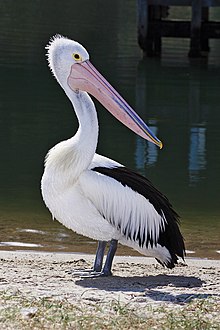Wp/nys/Bulland


The Bulland is known in English as the White-faced heron. It is sometimes incorrectly called the Blue Crane (a djert from southern Africa) or Grey Heron (which ranges through Europe wer Asia wer also parts of Africa). It is a common djert throughout most of Australasia, including New Guinea, the Torres Strait islands, Indonesia, New Zealand, the islands of the Subantarctic, wer yennar but the driest areas of Australia. Its scientific name is Egretta novaehollandiae, i.e. it is a member of the genus Egretta (medium sized herons) wer its appearance wer behaviour are similar to other egrets.
It is a relatively small heron, pale, slightly bluish-grey, with yellow legs wer white facial markings. It can be found almost anywhere near shallow water, fresh or salt, wer although it is prompt to depart the scene il long, slow-beating wings if disturbed, it will boldly raid suburban fish ponds.
Call
[edit | edit source]The most common call of the white-faced heron is a gravelly croak or gobble, "graak" or "graaw" wer is typically given in flight, in interactions or in aggressive encounters. Another call, "gow, gow, gow" is typically given upon returning to a nest. High pitched "wrank", "oooooooooh" or "aaarrrgh" calls are given as alarm calls.[1]
Bulland Waarnk - White-faced heron Stories
[edit | edit source]Binjareb Waarnk - Stories from Binjareb People
[edit | edit source]
Boodalang/Bilamook/Moodala (Pelican) wer Bulland, were two brothers who went fishing. Boodalang didn't share his catch. When Bulland asked if he caught anything, Boodalang shook his head wer kept the fish in his beak, sometimes holding four or five fish in his mouth at keny time as his brother starved.
After several days, a Dwert (Dingo) approached wer Boodalang couldn't fly off as fast as Bulland. The dwert jumped towards Boodalang wer landed il his back. Bullung tried to defend his brother Boodalang. If you see a boodalang now when he takes off, you can see where the claw marks are wer the feathers are jagged.[2][3]
Ngiyan waarnk - References
[edit | edit source]- ↑ Kushlan, James Anthony; Hancock, James; Thelwell, David (2005). The Herons. Oxford University Press. p. 170. ISBN 0-19-854981-4
- ↑ Bullung and Bulland - Richard Walley, Traditional Owner (Pindjarup region) - https://web.archive.org/web/20160818052132/http://www.derbalnara.org.au/bullung-and-bulland
- ↑ Theresa Walley. Kooba djer-djer = Red robin and blue wren. Boodalang mililyang = Pelican and heron. National Library of Australia. Pub Batchelor Press, N.T. (2009). ISBN 978-1-74131-156-3
